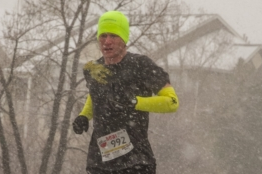One of my primary concerns around the virtual marathon on 3 October was mental fatigue. This isn’t boredom as my mind is always racing (no pun intended, really) and I enjoy the ability to lose myself in thought on long runs. Rather, pushing yourself at race pace while on your own outside of an official race is challenging and I could see it being quite easy to spiral into mental fatigue, especially if I was falling off the pace at all. It’s one reason I considered running the event with less emphasis on my time and more on savoring the run.
However, as I’ve gotten into the details of planning, it’s clear that there will be quite a lot to focus on over the course of 26.2 miles and the risk of mental fatigue seems less than I would have thought. On that note, at this point I’ll go for a 3:10 overall time and I’ve picked my course.
I’ve penciled in goal times for each of the 26.2 miles (including the .2!) based on how far along I am and where the hills are located. For example, if a mile includes a longer uphill segment, I’ve got a slower time goal. On race day, I’ll tape a card on my arm listing these splits and the cumulative time next to them so that I can quickly glance down to see how I’m doing. Doing this every mile isn’t a frequent distraction but it helps, and there’s more.
For hydration, my basic approach is that starting at the three mile point, I take a decent swallow of fluid every quarter mile. I’ve used less and more fluids than I expected on my longer runs but the every quarter mile strategy is a good minimum based on what I’ve experienced. If I hold to a 7:15 mile pace, that means taking a drink every 1:48 or so. My route is familiar enough that I know where most of the quarter mile points are but I will need to check my watch. Taking a drink every two minutes (roughly) may sound like long intervals, but I have missed a few on some long runs and so it does require some focus. This plus checking the mile splits keeps me fairly busy, and yet there’s even more.
Beyond the basic details of pace and fueling it will also be important to maintain the broad strategies and though that may seem obvious, it’s also easy to veer off of a plan. Sometimes you should change but generally you avoid it because if you’ve put time, experience, and evidence into the plan, it’s likely sound. While I don’t anticipate going out at a substantially faster pace and assuming I can hold that, if I’m rested and in the condition I hope I’m in, it can be easy to go out several seconds faster per mile and that also can set you back later. Adjusting this can be challenging as it’s risky to slow down too much and then have to make time back up, but you don’t want to burn out the engines early. On the fueling, if the day is cooler than anticipated, I might head into the final several miles thinking I can handle it with no further liquids but that would probably be a mistake.
Hydration and pace strategy will have to be designed for any long race, even a major marathon with thousands of people to keep you company. But, I hadn’t realized how much of a focus they can be and sticking to my overall plan, while properly hydrating and checking the per-mile times, should keep my brain pretty busy. (Given that my past marathons were 16-plus years ago, I also suspect that my hydration plan back then was to drink at the aid stations and then keep trucking–probably a benefit of being younger that I didn’t fully appreciate at the time.) Mental fatigue could still be a factor but it seems less likely than when I first started considering how to approach this race. How it actually plays out remains to be seen…
